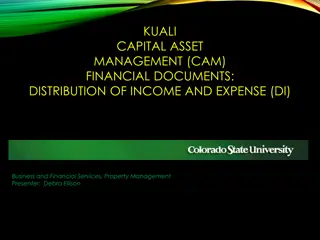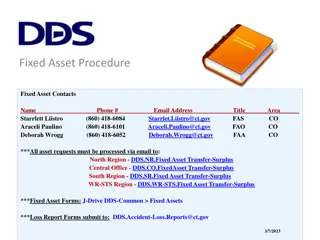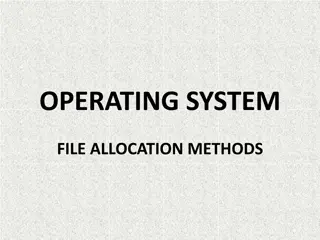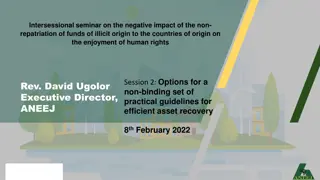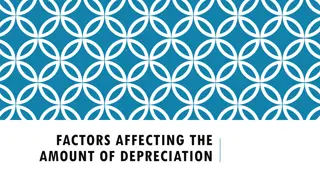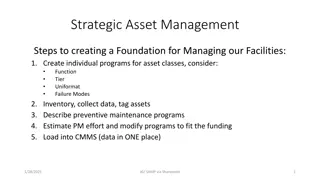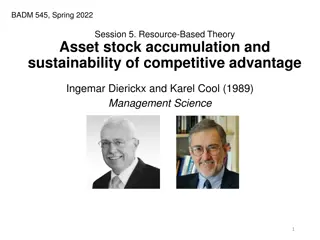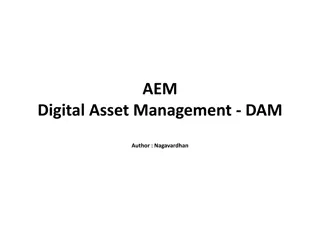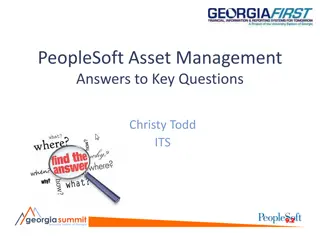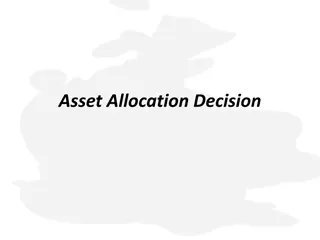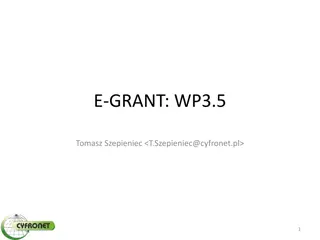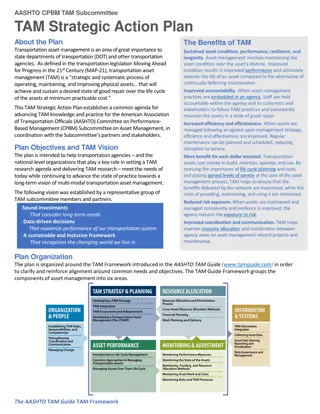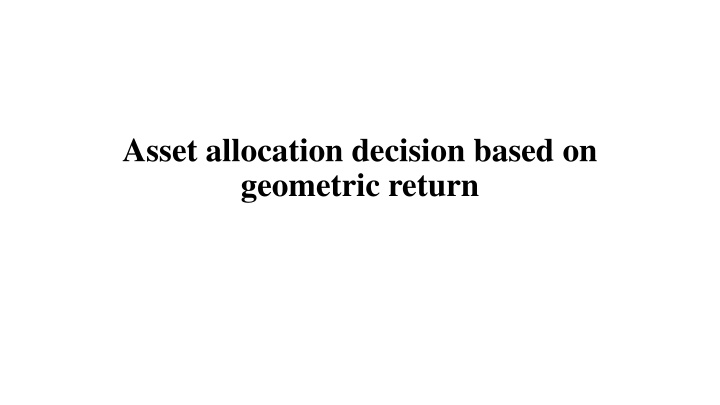
Asset Allocation Decision Based on Geometric Returns
Learn about asset allocation decisions based on geometric returns in investments. Understand how to allocate investments between risky and risk-free assets, with examples and solutions provided. Explore the implications of geometric averages on investment values.
Download Presentation

Please find below an Image/Link to download the presentation.
The content on the website is provided AS IS for your information and personal use only. It may not be sold, licensed, or shared on other websites without obtaining consent from the author. If you encounter any issues during the download, it is possible that the publisher has removed the file from their server.
You are allowed to download the files provided on this website for personal or commercial use, subject to the condition that they are used lawfully. All files are the property of their respective owners.
The content on the website is provided AS IS for your information and personal use only. It may not be sold, licensed, or shared on other websites without obtaining consent from the author.
E N D
Presentation Transcript
Asset allocation decision based on geometric return
The most common problem in investment process is the asset allocation problem. How much you would invest in risky assets, such as stocks? How much you would invest in relatively risk free assets, such as bonds? In standard investment theory, it is determined by your utility function. However, many of us don t really know what our utility function is. In a geometric return based theory, with a specific asset allocation decision, we will know the most likely investment value end the end of horizon.
Some examples 1. How much to invest in stocks and bonds? 2. How much to invest in futures market? 3. How much CDS to buy, given your own forecasting? 4. How much to bet in Blackjack game? 5. How much unemployment insurance to provide by the government?
The standard investment theory can provide answer only the first question. Here the answer is very vague. It depends on your own utility, kicking the ball back to yourself. We will discuss how a geometric return based theory answer these questions.
A simple example Suppose there are two assets in the market. One is risky. One is risk free. The first asset costs one dollar. After one year, the asset either worth two dollars with 50% probability, or worth half dollar with 50% probability. The second asset costs one dollar. After one year, the asset still worth one dollar. How much should an investor allocate his resource to each asset?
Solution Assume the total amount of investment is one dollar. The amount allocated to risky asset is x. The remaining is allocated to risk free asset, which is 1-x. If the value of the risky asset becomes 2 after one year, the total investment will be worth 2x+(1-x). If the value of the risky asset becomes 0.5 after one year, the total investment will be worth 0.5x+(1-x).
The geometric average of the investment value is (2? + 1 ? )0.5(0.5? + 1 ? )0.5 We will attempt to maximize Formula (3.1). Equivalently, we can maximize 3.1 2? + 1 ? 0.5? + 1 ? (3.2) This is simpler to calculate.
Simplify (3.2), we get 2? + 1 ? 0.5? + 1 ? = (1 + ?)(1-0.5x) = 0.5?2+ 0.5? + 1 (3.3)
Differentiating (3.3), we get ? ?? 0.5?2+ 0.5? + 1 = ? + 0.5 3.4 Let the above formula equal to zero. We get ? = 0.5 (3.5)
To maximize the geometric return, or compound return of our asset, we should allocate half of the money to risky asset and another half to the risk free asset. With this asset allocation decision, the geometric return of the asset will be, according to (3.1), 0.50.5 0.5 + 1 0.5 0.5 1 2 0.5 + 1 0.5 = 1.5 0.750.5 1 0.06 (3.6)
After one year, the most likely investment value will be 1.06. Since this investment strategy maximizes expected compound return, it is also called growth optimum investment strategy (Hakansson and Ziemba, 1995).
Not every investor will attempt to maximize geometric return of their investment. Some prefer safer investment strategies. For example, instead of investing 50% of their asset to risky asset, some may invest only 30% to risky asset and keep 70% in risk free asset. In this case, the geometric rate of return is, according to (3.1), 0.50.5 30% + 1 30% 0.5= 2 30% + 1 30% 1.30.50.850.5 0.05
In this way, the investor can obtain lower but less volatile return. Suppose he plans to invest one thousand dollar for ten year, he would expect the final asset value to be around 1000 (1 + 0.05)10= 1629 ??????
Formal theory We will derive the formal theory of asset allocation. We will consider a simple market with a risk free asset and a risky asset. When interest rate is measured on the inflation adjusted basis, the risk free interest rate can be set to be zero as a good approximation to reality. Here we will assume the return of the risk free asset to be zero. The payoffs of one unit risky asset can be either 1 + d with probability p or 1 d with probability 1-p.
Investors aim at maximizing expected geometric return (Kelly, 1956; Latane and Tuttle, 1967). Assume the portfolio contains a portion x of risky asset and the remaining portion of 1 x is risk free asset. We can calculate the expected rate of return of this portfolio. The expected geometric return of the portfolio is ((1 ?) + ?(1 + ?))?((1 ?) + ?(1 ?))1 ? 1 = (1 + ??)?(1 ??)1 ? 1 (4.1)
To determine the value of x at which the portfolio will have the maximal rate of return, we differentiate the above formula with respect to x. ? ??((1 + ??)?(1 ??)1 ? 1) = ?(1 + ??)? 1(1 ??) ?(2? 1 ??) The above differentiation equals zero when ? =2? 1 (4.2) ?
At this value of x, the portfolio obtains the highest expected geometric return. Plug the value of x into (4.1), the expected rate of return is (1 + 2? 1)?(1 (2? 1))1 ? 1 = 2??(1 ?)1 ? 1 (4.3) Afirst order approximation of (4.3) is ??(2??(1 ?)1 ?) = ???? + (1 ?)??(1 ?) + ??2 This is the value of information. This shows that the return from investment is equal to the value of information (Kelly,1956).
From (4.2), the information about a stock determines the level of holding of the stock. In the following, we will apply the theory to calculate several numerical examples on the level of holding of risky assets. The payoffs of one unit risky asset can be either 1 + d with probability p or 1 d with probability 1-p. We can calibrate the value of p and d with the empirical data on return and standard deviation.
The arithmetic mean rate of return of the risky asset is ?? + (1 ?)( ?) = (2? 1)? (4.4) and the standard deviation of the risky asset is {?[?? (2? 1)?]2+ (1 p)[(1 p)( d) (2p 1)?]2}1/2= 2? ?(1 ?) (4.5) respectively.
The above relations show that there is a one to one correspondence between (p, d) and (mean, standard deviation). The numerical representation by (p, d), just like mean and standard deviation, is a simplified characteristic on the movements of the risky asset. Assume (p, d) = (0.65, 0.25). The arithmetic return will be 7.5%, the standard deviation is about 24%. This is close to the data in some equity markets. While we assume a risky asset makes only two discrete movements with corresponding probabilities, in reality, a risky asset can make many different movements with corresponding probabilities.
Different people at different times in different places may have different opinions about the future of the stock markets. We will calculate the proportions of asset to be allocated to the risky asset with different expectations. When p is equal to 55%, 57.5%, 60%, 62.5%, 65% while keeping d fixed at 0.25, the optimal allocations to risky asset, following formula (4.2), are
2? 1 ? = 0.6 =2 0.55 1 0.25 = 0.4 2 0.575 1 0.25 2 0.60 1 0.25 2 0.625 1 0.25 2 0.65 1 0.25 = 0.8 = 1.0 (4.6) = 1.2
while the arithmetic means of the risky asset, following formula (4.4), are 25 . 0 ) 1 55 . 0 2 ( = 5 . 2 = % 2 ( . 0 575 ) 1 . 0 25 = . 3 75 % ) 1 2 ( 6 . 0 . 0 25 5 % = ) 1 2 ( . 0 625 . 0 25 . 6 25 % ) 1 = 2 ( . 0 65 . 0 25 5 . 7 %
The real returns of the best performing stock markets in the world, such as United States, over the second half of the last century are close to or above 6.25%. This justifies the standard statement of high risk, high return and the common practice of allocating most or all assets in risky securities in long term investments.
When the arithmetic rate of return is above 6.25% per annum, even higher rates of return can be achieved by borrowing funds to invest in risky assets, as calculated from (4.6). However, if the future expected real returns of risky assets are lower, the proportions of risky assets in investment portfolios should be lower as well to achieve maximum expected rate of returns (McEnally, 1986).
Applications to the futures market The asset allocation decision can be applied to the futures market as well. Since the futures market are highly leveraged, the high risk high return theory will cause quick ruin for excess risk taker. The geometric return theory will provide a quantitative guide for sound risk management.
We will use an example to illustrate the relation between risk and return of portfolios with different weights of risky asset. Suppose p is equal to 0.6 and d is equal to 0.25 for the risky asset. In three portfolios with risky assets at 60%, 80% and 100%, the geometric returns, calculated from (4.1), are proportion of risky asset 0.6 0.8 1 geometric return of the portfolio 0.01903 0.02034 0.01899
The volatility of return of the portfolios will increase with the proportion of the risky asset. But when the weights of risky assets are higher than 80%, the geometric return will decline, as shown from the table in the previous slide.
Example: Investment in CDS A CDS is based on a loan to XYZ Corp. CDS premium is 1.50% per year. If XYZ goes bankrupt, the recovery value on the underlying loan is 40%. An investor has a total wealth of 100 million. He thinks the probability of XYZ go bankrupt in one year is 10%. How much CDS he should buy to maximize his expected future wealth? Assume this is his only investment, he will pay CDS premium for one year, the risk free return is zero.
initial total wealth notional amount of debt CDS premium total CDS premium per year recovery rate from loan CDS payment in loan default probability of default final wealth without default final wealth with default expected wealth, geometric average 100million 512.82million 1.50%per year 7.6923million 40% 307.69million 10% 92.308 400 106.89
An application to Blackjack Geometric return based investment theory was first developed by John Kelly in 1956. The earliest application of this theory was probably from Ed Thorp, a mathematician interested in blackjack (Poundstone, 2005). With the help of a computer, Thorp found the probability of winning is around 51% in blackjack for a whole deck of cards, with correct strategies. When some cards are being played, the probability of winning may change for the rest of the cards. Thorp s question was to determine the optimal amount of betting with varying probabilities of winning. He used Kelly s theory to solve the problem. We will briefly discuss his calculation.
In Blackjack, you bet a certain amount of money each hand. When you lose, you lose your bet. When you win, you double your bet. This means d = 1 in formula (4.2). When the winning probability is 51%, the optimal amount of betting, according to (4.2), is ? =2 0.51 1 = 0.02 = 2% 1 You should bet 2% of your capital each time. The expected return, from formula (4.4), is 0.51??0.51 + 0.49??0.49 + ??2 = 0.0002
This is an extremely small number, assuming that you adopt the best strategies. When some cards are being played, the probability of winning may change for the rest of the cards. Suppose the winning probability rises to 52%, or 53%, what are the amounts of betting and their corresponding returns? We will do the same calculation. The results are shown in the following. The amount of betting, from formula (4.2) would be 2 0.52 1 1 2 0.53 1 1 = 0.04 = 4% , = 0.06 = 6%
The expected returns, from formula (4.4), are 0.52??0.52 + 0.48??0.48 + ??2 = 0.0008, 0.53??0.53 + 0.47??0.47 + ??2 = 0.0018
The expected amount of money after one thousand hand of playing d p amount of betting return hands 1 1 0.51 0.02 0.53 0.06 0.0002 1000 0.0018 1000 final amount of money 1.22142 6.05619
Should we attempt to maximize geometric return? When we attempt to maximize geometric return, the return volatility is often higher than the level we are comfortable with. We may choose portfolios with lower risk. We can calculate the corresponding geometric return. Another reason to choose a more conservative portfolio is that we often overestimate the return of our favorite stocks. By taking a more conservative approach, we may actually achieve near maximal geometric return.
Geometric return and arithmetic return The key point is that geometric return gives us more accurate description of return than arithmetic return. That is why we should measure asset returns with geometric return, instead of arithmetic return in the standard investment theory. We don t necessarily pursue a strategy that maximize geometric return.
The life of Ed Thorp (1932 - A mathematician interested in blackjack In 1961, he presented a paper titled Fortune s Formula: A Winning Strategy for Blackjack This attracted a lot of media attention. Some people offered to bankroll Thorp for a real play.
They went to Reno casinos. Thorp used Kelly s formula to determine his betting size in blackjack. They made a lot of money Later Thorp wrote Beat the Dealer (1966), in which he explained the game strategy in detail.
After he got famous in blackjack, it became difficult for him to play in casinos again. Thorp turned his attention to the stock market, the world s largest casino. Initially, he wasn t successful in stock picking. He figured his edge is in mathematics. So he focused on technically complicated instruments, such as warrants.
He studied whether warrants are undervalued or overvalued relative to stocks. He buy undervalued warrants or short overvalued warrants, hedged with underlying stocks. He did very well on his personal account. He tried to get more money for investment. But he was not successful.
He, together with Sheen Kassouf wrote Beat the Market (1967) They tried to use the book to attract potential investors. He attracted the attention of Jay Regan, an east coast broker. They formed a hedge fund Convertible Hedge Associates in 1969. The fund had been very successful. Thorp is sometimes called the father of quantitative financing. For details, please read Fortune s formula, 2005 by William Poundstone
Thorp has played an important role in popularizing Kellys formula. He, with the book Beat the Market, also played an important role in generating interest on derivatives research. This led to the ground breaking work of Black Scholes.
Asset pricing We mainly discuss asset allocation. The theory can also be applied to asset pricing. First we will reflect on asset pricing theory in standard investment theory. In CAPM, we don t really price an asset. Instead, the given market price of an asset is assumed to be rational. The expected market return is also unknown. We predict the return of a particular asset relative to the expected market return based on its beta.
In geometric return based investment theory, the pricing of an asset can be calculated based on the expected payoff in the future. This established the relation between future expected payoff and current price. However, the calculations are extremely complex and involved. Interested readers should consult Chapter Three: An Investment Theory Based on Geometric Return Of the book, Finance: A New Theoretical Foundation


